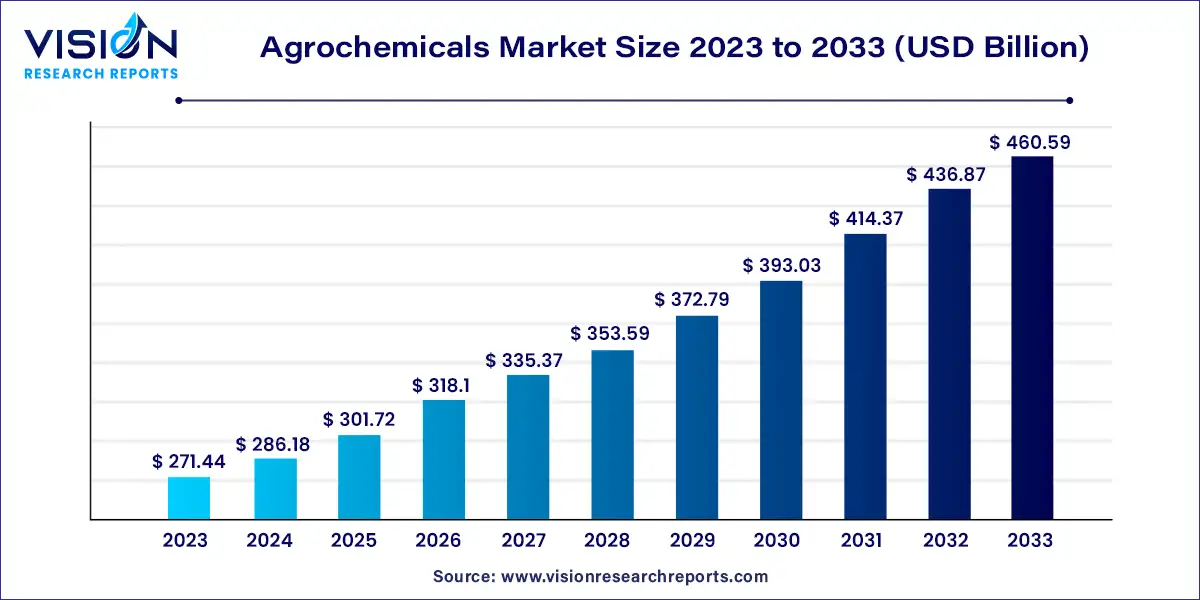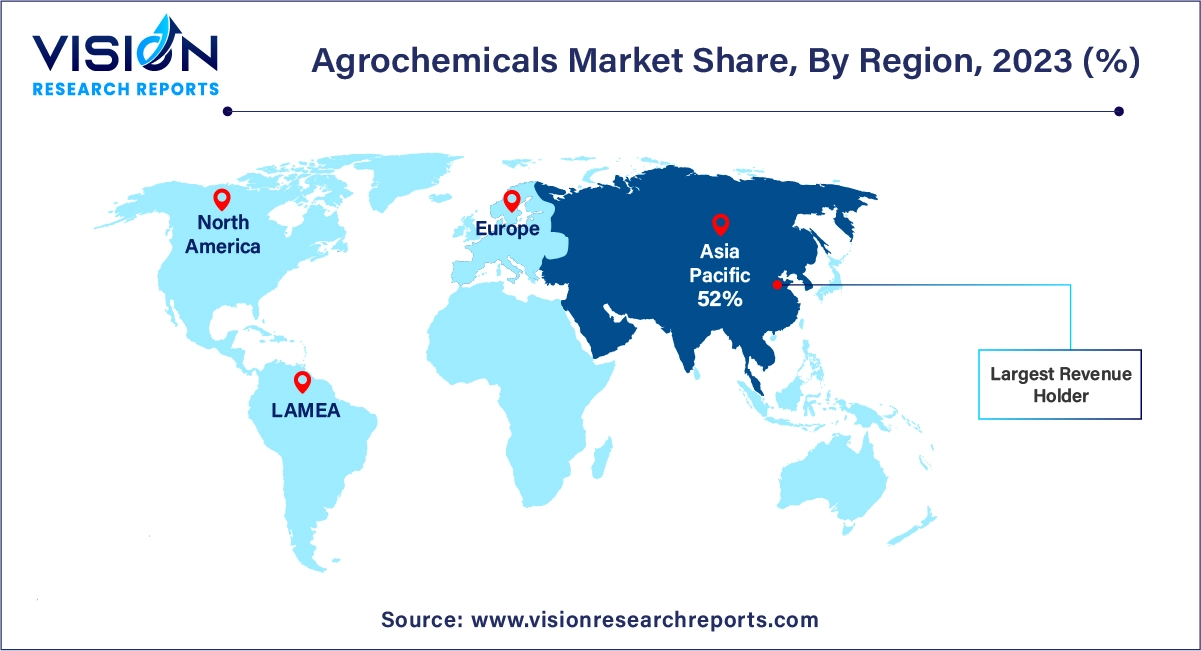The global agrochemicals market size was estimated at around USD 271.44 billion in 2023 and it is projected to hit around USD 460.59 billion by 2033, growing at a CAGR of 5.43% from 2024 to 2033. The agrochemicals market encompasses a broad range of chemical products used in agriculture to enhance crop productivity and protection. These include fertilizers, pesticides, herbicides, fungicides, and insecticides. The global agrochemicals market plays a critical role in the agricultural sector by boosting yields, controlling pests and diseases, and ensuring food security.

The agrochemicals market is experiencing robust growth due to an increasing global population drives the demand for higher agricultural yields to ensure food security. This heightened demand for food necessitates advanced agricultural inputs, including agrochemicals, to maximize crop productivity and manage resources efficiently. Additionally, technological advancements in agrochemical formulations and application methods enhance their effectiveness and efficiency, further stimulating market growth. Innovations such as precision agriculture and smart farming practices optimize the use of agrochemicals, reducing waste and improving crop outcomes. Government initiatives and subsidies also play a crucial role, as they support the adoption of agrochemical products and promote sustainable agricultural practices. Together, these factors contribute to the continuous expansion of the agrochemicals market, addressing the evolving needs of modern agriculture.
The Asia-Pacific region held a significant revenue share of 52% in 2023. This dominance is driven by the large population, increasing food demand, and rising agricultural production in countries such as India, China, Japan, and Australia. According to researchers from the University of Melbourne and Zhejiang, China is a major player in pesticide use, accounting for about 30% of global pesticide and fertilizer consumption and supplying over 90% of the world's technical raw material needs.
| Attribute | Asia Pacific |
| Market Value | USD 141.14 Billion |
| Growth Rate | 5.44% CAGR |
| Projected Value | USD 239.5 Billion |
North America is home to many agrochemical manufacturers and is expected to be the largest market for organic agrochemicals, including bio-fertilizers and bio-pesticides, due to strict environmental regulations. The region's thriving dairy industry and favorable climate conditions for crops like corn and maize are key drivers of market growth.

In Europe, countries like Germany, France, the UK, and Italy were major contributors to market growth in 2023. However, Spain, Bulgaria, Romania, and other nations have also seen rapid growth due to increased investments in agriculture and improved water preservation techniques. These factors have led to enhanced agricultural activities in the region, thereby boosting the demand for agrochemicals.
In 2023, the fertilizers segment led the market with a commanding revenue share of 77%. This dominance is primarily due to farmers’ increasing focus on boosting crop yields within shorter timeframes. The rising global demand for food and crops is putting pressure on agricultural lands, prompting farmers to use more fertilizers to enhance productivity and crop output.
The fertilizer segment includes various types such as nitrogenous, phosphatic, potassic, secondary fertilizers, and others. Among these, nitrogenous fertilizers are projected to experience rapid growth during the forecast period. These fertilizers are widely used due to their ability to accelerate plant growth and improve yields. However, excessive use of nitrogenous fertilizers can negatively impact the environment, including water sources.
The cereals and grains segment captured a significant share of 48% in 2023. This is attributed to the high consumption of cereals and grains like rice, wheat, rye, corn, oats, sorghum, and barley across various regions. Agrochemicals are predominantly utilized for these crops in Asia-Pacific and North America, where high volumes of wheat and corn are cultivated, notably in countries such as China and the U.S. Non-ionic surfactants, along with agrochemicals, are typically recommended for these crops.
The oilseeds and pulses segment, which includes crops such as sunflower seeds, soybeans, and legumes, is also experiencing growth. Increased focus on oilseed production, particularly in major producers like Brazil, China, and the U.S., is expected to drive demand for agrochemicals in these countries.
The rising global consumption of vegetarian foods and increasing health consciousness among consumers are contributing to the demand for fruits and vegetables. This growing demand is anticipated to positively impact the agrochemicals market. Additionally, increased production of fruit and vegetable crops is expected to further drive market growth.
The "others" segment includes various crops such as herbs, tea, spices, and coffee. The growing preference for beverages like tea and coffee, along with the expansion of the hospitality industry, is likely to boost agrochemical demand in this segment.
By Product
By Application
By Region
Chapter 1. Introduction
1.1. Research Objective
1.2. Scope of the Study
1.3. Definition
Chapter 2. Research Methodology
2.1. Research Approach
2.2. Data Sources
2.3. Assumptions & Limitations
Chapter 3. Executive Summary
3.1. Market Snapshot
Chapter 4. Market Variables and Scope
4.1. Introduction
4.2. Market Classification and Scope
4.3. Industry Value Chain Analysis
4.3.1. Raw Material Procurement Analysis
4.3.2. Sales and Distribution Channel Analysis
4.3.3. Downstream Buyer Analysis
Chapter 5. COVID 19 Impact on Agrochemicals Market
5.1. COVID-19 Landscape: Agrochemicals Industry Impact
5.2. COVID 19 - Impact Assessment for the Industry
5.3. COVID 19 Impact: Global Major Government Policy
5.4. Market Trends and Opportunities in the COVID-19 Landscape
Chapter 6. Market Dynamics Analysis and Trends
6.1. Market Dynamics
6.1.1. Market Drivers
6.1.2. Market Restraints
6.1.3. Market Opportunities
6.2. Porter’s Five Forces Analysis
6.2.1. Bargaining power of suppliers
6.2.2. Bargaining power of buyers
6.2.3. Threat of substitute
6.2.4. Threat of new entrants
6.2.5. Degree of competition
Chapter 7. Competitive Landscape
7.1.1. Company Market Share/Positioning Analysis
7.1.2. Key Strategies Adopted by Players
7.1.3. Vendor Landscape
7.1.3.1. List of Suppliers
7.1.3.2. List of Buyers
Chapter 8. Global Agrochemicals Market, By Product
8.1. Agrochemicals Market, by Product, 2024-2033
8.1.1. Fertilizers
8.1.1.1. Market Revenue and Forecast (2021-2033)
8.1.2. Crop Protection Chemicals
8.1.2.1. Market Revenue and Forecast (2021-2033)
8.1.3. Plant Growth Regulators
8.1.3.1. Market Revenue and Forecast (2021-2033)
8.1.4. Others
8.1.4.1. Market Revenue and Forecast (2021-2033)
Chapter 9. Global Agrochemicals Market, By Application
9.1. Agrochemicals Market, by Application, 2024-2033
9.1.1. Cereal & Grain
9.1.1.1. Market Revenue and Forecast (2021-2033)
9.1.2. Oilseeds & Pulses
9.1.2.1. Market Revenue and Forecast (2021-2033)
9.1.3. Fruits & Vegetables
9.1.3.1. Market Revenue and Forecast (2021-2033)
9.1.4. Others
9.1.4.1. Market Revenue and Forecast (2021-2033)
Chapter 10. Global Agrochemicals Market, Regional Estimates and Trend Forecast
10.1. North America
10.1.1. Market Revenue and Forecast, by Product (2021-2033)
10.1.2. Market Revenue and Forecast, by Application (2021-2033)
10.1.3. U.S.
10.1.3.1. Market Revenue and Forecast, by Product (2021-2033)
10.1.3.2. Market Revenue and Forecast, by Application (2021-2033)
10.1.4. Rest of North America
10.1.4.1. Market Revenue and Forecast, by Product (2021-2033)
10.1.4.2. Market Revenue and Forecast, by Application (2021-2033)
10.2. Europe
10.2.1. Market Revenue and Forecast, by Product (2021-2033)
10.2.2. Market Revenue and Forecast, by Application (2021-2033)
10.2.3. UK
10.2.3.1. Market Revenue and Forecast, by Product (2021-2033)
10.2.3.2. Market Revenue and Forecast, by Application (2021-2033)
10.2.4. Germany
10.2.4.1. Market Revenue and Forecast, by Product (2021-2033)
10.2.4.2. Market Revenue and Forecast, by Application (2021-2033)
10.2.5. France
10.2.5.1. Market Revenue and Forecast, by Product (2021-2033)
10.2.5.2. Market Revenue and Forecast, by Application (2021-2033)
10.2.6. Rest of Europe
10.2.6.1. Market Revenue and Forecast, by Product (2021-2033)
10.2.6.2. Market Revenue and Forecast, by Application (2021-2033)
10.3. APAC
10.3.1. Market Revenue and Forecast, by Product (2021-2033)
10.3.2. Market Revenue and Forecast, by Application (2021-2033)
10.3.3. India
10.3.3.1. Market Revenue and Forecast, by Product (2021-2033)
10.3.3.2. Market Revenue and Forecast, by Application (2021-2033)
10.3.4. China
10.3.4.1. Market Revenue and Forecast, by Product (2021-2033)
10.3.4.2. Market Revenue and Forecast, by Application (2021-2033)
10.3.5. Japan
10.3.5.1. Market Revenue and Forecast, by Product (2021-2033)
10.3.5.2. Market Revenue and Forecast, by Application (2021-2033)
10.3.6. Rest of APAC
10.3.6.1. Market Revenue and Forecast, by Product (2021-2033)
10.3.6.2. Market Revenue and Forecast, by Application (2021-2033)
10.4. MEA
10.4.1. Market Revenue and Forecast, by Product (2021-2033)
10.4.2. Market Revenue and Forecast, by Application (2021-2033)
10.4.3. GCC
10.4.3.1. Market Revenue and Forecast, by Product (2021-2033)
10.4.3.2. Market Revenue and Forecast, by Application (2021-2033)
10.4.4. North Africa
10.4.4.1. Market Revenue and Forecast, by Product (2021-2033)
10.4.4.2. Market Revenue and Forecast, by Application (2021-2033)
10.4.5. South Africa
10.4.5.1. Market Revenue and Forecast, by Product (2021-2033)
10.4.5.2. Market Revenue and Forecast, by Application (2021-2033)
10.4.6. Rest of MEA
10.4.6.1. Market Revenue and Forecast, by Product (2021-2033)
10.4.6.2. Market Revenue and Forecast, by Application (2021-2033)
10.5. Latin America
10.5.1. Market Revenue and Forecast, by Product (2021-2033)
10.5.2. Market Revenue and Forecast, by Application (2021-2033)
10.5.3. Brazil
10.5.3.1. Market Revenue and Forecast, by Product (2021-2033)
10.5.3.2. Market Revenue and Forecast, by Application (2021-2033)
10.5.4. Rest of LATAM
10.5.4.1. Market Revenue and Forecast, by Product (2021-2033)
10.5.4.2. Market Revenue and Forecast, by Application (2021-2033)
Chapter 11. Company Profiles
11.1. Royal Dutch Shell plc
11.1.1. Company Overview
11.1.2. Product Offerings
11.1.3. Financial Performance
11.1.4. Recent Initiatives
11.2. OCP Group
11.2.1. Company Overview
11.2.2. Product Offerings
11.2.3. Financial Performance
11.2.4. Recent Initiatives
11.3. SABIC
11.3.1. Company Overview
11.3.2. Product Offerings
11.3.3. Financial Performance
11.3.4. Recent Initiatives
11.4. PhosAgro
11.4.1. Company Overview
11.4.2. Product Offerings
11.4.3. Financial Performance
11.4.4. LTE Scientific
11.5. Yara International
11.5.1. Company Overview
11.5.2. Product Offerings
11.5.3. Financial Performance
11.5.4. Recent Initiatives
11.6. Rashtriya Chemical Fertilizer Ltd.
11.6.1. Company Overview
11.6.2. Product Offerings
11.6.3. Financial Performance
11.6.4. Recent Initiatives
11.7. Adjuvants Plus Inc.
11.7.1. Company Overview
11.7.2. Product Offerings
11.7.3. Financial Performance
11.7.4. Recent Initiatives
11.8. Merck KGaA
11.8.1. Company Overview
11.8.2. Product Offerings
11.8.3. Financial Performance
11.8.4. Recent Initiatives
11.9. Praxair Technology, Inc.
11.9.1. Company Overview
11.9.2. Product Offerings
11.9.3. Financial Performance
11.9.4. Recent Initiatives
11.10. Southern Agricultural Insecticides, Inc.
11.10.1. Company Overview
11.10.2. Product Offerings
11.10.3. Financial Performance
11.10.4. Recent Initiatives
Chapter 12. Research Methodology
12.1. Primary Research
12.2. Secondary Research
12.3. Assumptions
Chapter 13. Appendix
13.1. About Us
13.2. Glossary of Terms
 Cross-segment Market Size and Analysis for
Mentioned Segments
Cross-segment Market Size and Analysis for
Mentioned Segments
 Additional Company Profiles (Upto 5 With No Cost)
Additional Company Profiles (Upto 5 With No Cost)
 Additional Countries (Apart From Mentioned Countries)
Additional Countries (Apart From Mentioned Countries)
 Country/Region-specific Report
Country/Region-specific Report
 Go To Market Strategy
Go To Market Strategy
 Region Specific Market Dynamics
Region Specific Market Dynamics Region Level Market Share
Region Level Market Share Import Export Analysis
Import Export Analysis Production Analysis
Production Analysis Others
Others